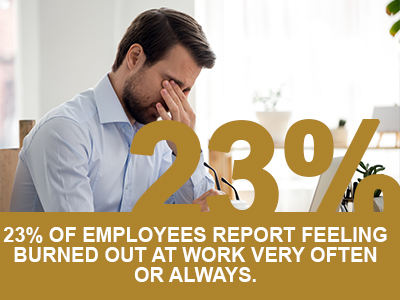
By Heather Nezich, courtesy SBAM Approved Partner ASE
According to the World Health Organization (WHO), while employee burnout is not yet considered a medical condition, it is an “occupational phenomenon” and a diagnosable condition.
WHO describes employee burnout as “a syndrome conceptualized as resulting from chronic workplace stress that has not been successfully managed. It is characterized by three dimensions: (1) feelings of energy depletion or exhaustion; (2) increased mental distance from one’s job, or feelings of negativism or cynicism related to one’s job; and (3) reduced professional efficacy. Burnout refers specifically to phenomena in the occupational context and should not be applied to describe experiences in other areas of life.”
A Gallup study of nearly 7,500 full-time employees found that 23% reported feeling burned out at work very often or always, while an additional 44% reported feeling burned out sometimes.
Job burnout accounts for an estimated $125 billion to $190 billion in healthcare spending each year and has been attributed to type 2 diabetes, coronary heart disease, gastrointestinal issues, high cholesterol, and even death for those under the age of 45.
Burnt-out employees tend to be less aware of their surroundings which can affect workplace safety. This can result in misuse of heavy equipment, delayed emergency response, poor driving, and much more. All of these issues can result in workers’ compensation claims.
Unfair treatment at work, unreasonable deadlines, unmanageable workload, lack of support from managers, and the added stress from having to respond to emails and texts during off hours are the primary drivers of employee burnout.
How can employers help to prevent their employees from burnout?
-
Managers should be trained to recognize common warning signs such as trouble concentrating, increased fatigue, low morale, anxiety, alcohol or drug abuse, increased workplace incidents, and workplace violence.
-
Talk to your employees about employee burnout. Offer any training available. Remind them of any EAP available to them.
-
Encourage the use of allotted/earned vacation time.
-
Encourage coworkers to speak up if they suspect a colleague is experiencing burnout. OSHA law prohibits you from retaliating or discriminating against a worker for reporting a safety issue, injury, or illness.
-
Evaluate workloads often.
-
Promote and encourage work/life balance.
-
Encourage breaks throughout the day.